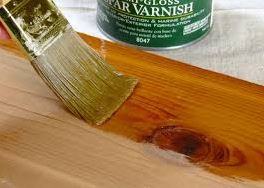What is the difference between Paint & Varnish?
Paint and varnish are two commonly used finishes applied on wood and other materials. Here is a
comparison between them in terms of appearance, application, protective properties, and drying time.
But before moving forward lets first understand what exactly varnish and paint is. And, if you are well aware of the both, please proceed to the next section.
What is Varnish?
resin dissolved in a liquid for applying on wood, metal, or other materials to form a hard, clear, shiny surface when dry
Varnish is a clear transparent hard protective finish or film. Varnish has little or no color and has no added pigment as opposed to paint or wood stain which contains pigment. However, some varnish products are marketed as a combined stain and varnish. Varnish is primarily used in wood finishing applications where the natural tones and grains in the wood are intended to be visible. It is applied over wood stains as a final step to achieve a film for gloss and protection. Varnish finishes are usually glossy but may be designed to produce satin or semi-gloss sheens by the addition of “flatting” agents.
The term “varnish” refers to the finished appearance of the product. It is not a term for any single or specific chemical composition or formula. There are many different compositions that achieve a varnish effect when applied. A distinction between spirit-drying (and generally removable) “lacquers” and chemical-cure “varnishes” (generally thermosets containing “drying” oils) is common, but varnish is a broad term historically and the distinction is not strict.

VARNISH

PAINT
What is Paint?
A substance that is applied as a liquid or paste, and dries into a solid coating that protects or adds color/colour to an object or surface to which it has been applied.
Paint is any pigmented liquid, liquefiable, or mastic composition that, after application to a substrate in a thin layer, converts to a solid film. It is most commonly used to protect, color, or provide texture to objects. Paint can be made or purchased in many colors—and in many different types, such as watercolor, synthetic, etc. Paint is typically stored, sold, and applied as a liquid, but most types dry into a solid.
Varnish vs Paint
Varnish has little or no colour, is transparent, and has no added pigment, as opposed to paints, which
contain pigment and generally range from opaque to translucent. Varnishes are also applied over wood
stains as a final step to achieve a film for gloss and protection. It is used when one wishes to retain the
natural beauty of wood.
A primer paint coat is usually required before applying top coats of paint. If the surface is not primed,
the paint will not adhere to the surface and it will peel off very easily. Paint can be applied with a brush, a
roller, or a spray gun. Varnish can be applied directly to bare or stained wood that is free of dust. The
traditional way of applying varnish is with a brush but it can also be sprayed or wiped on.
A brushed on oil-based paint can take up to 8 hours to dry where as a sprayed on paint may dry in less
than 1 hour. One of the biggest challenges with varnish is its long drying time which allows pesky dust
particles to settle on the surface. You can generally figure on 24 hours for varnish to dry although newer
water-based formulations and polyurethane often dry more quickly.
For interior applications, paint and varnish perform both provide decent protection against water and
solvents. For outdoor applications, paint is more protective and longer lasting than varnish. The pigments
in paint provide superior UV resistance compared to varnish and other clear finishes. Varnish will last only
1 to 2 years on wood exposed to sun throughout compared to 7 to 10 years for paint.
Get house painters, Paint and Varnish done with professional painters in Bangalore with Yes Painter.



I am perpetually thought about this, regards for putting up.